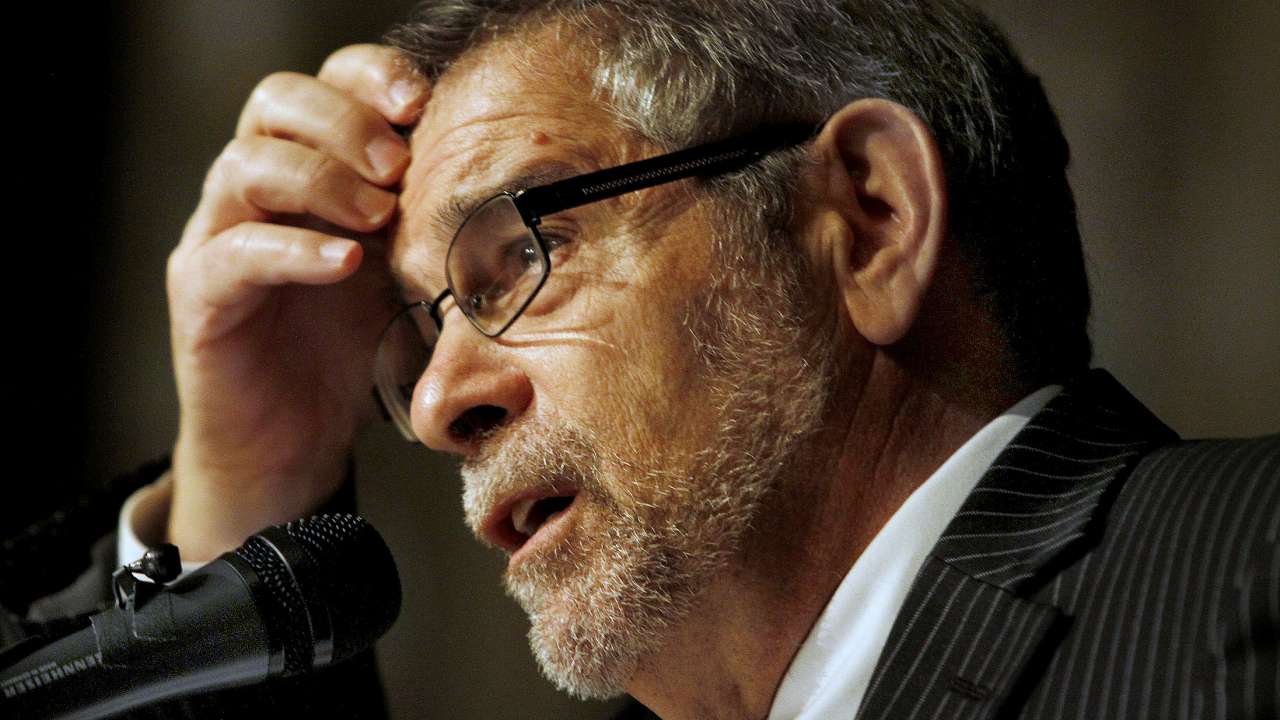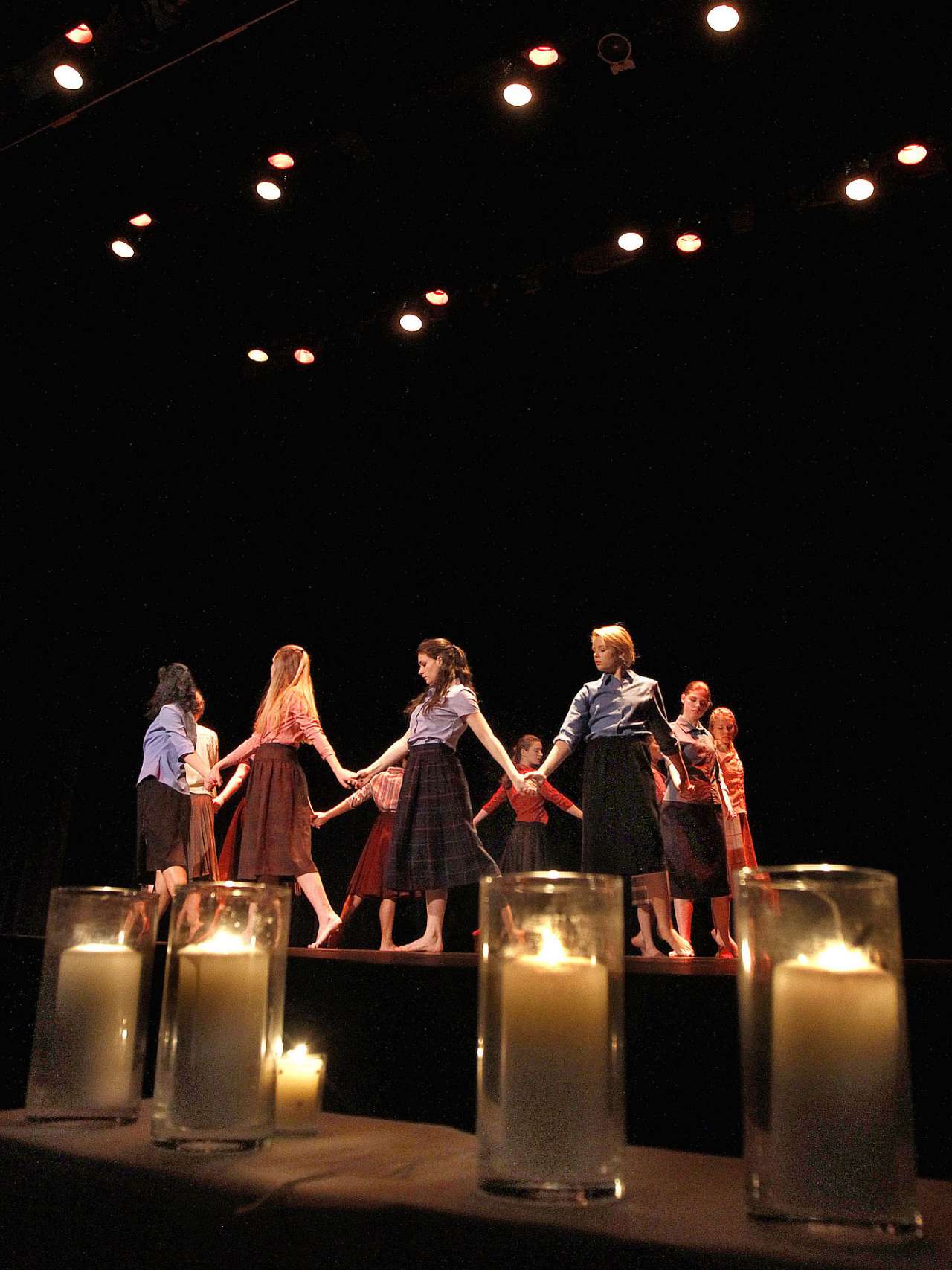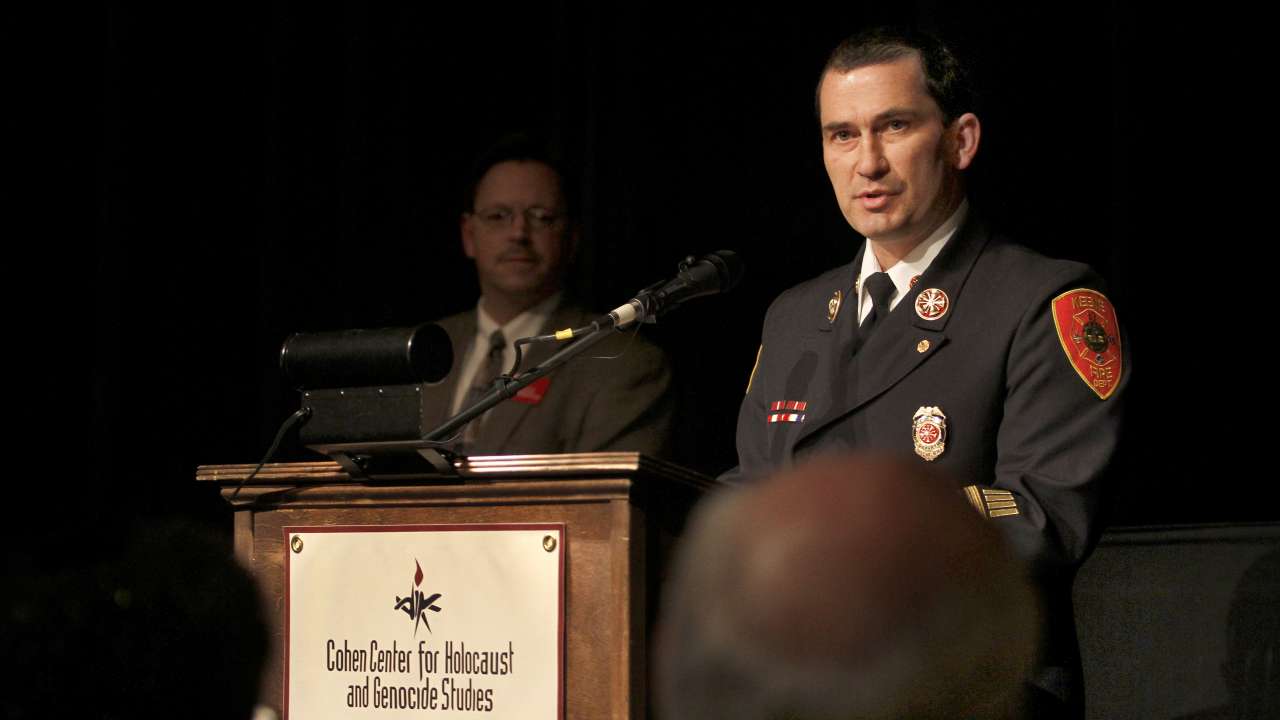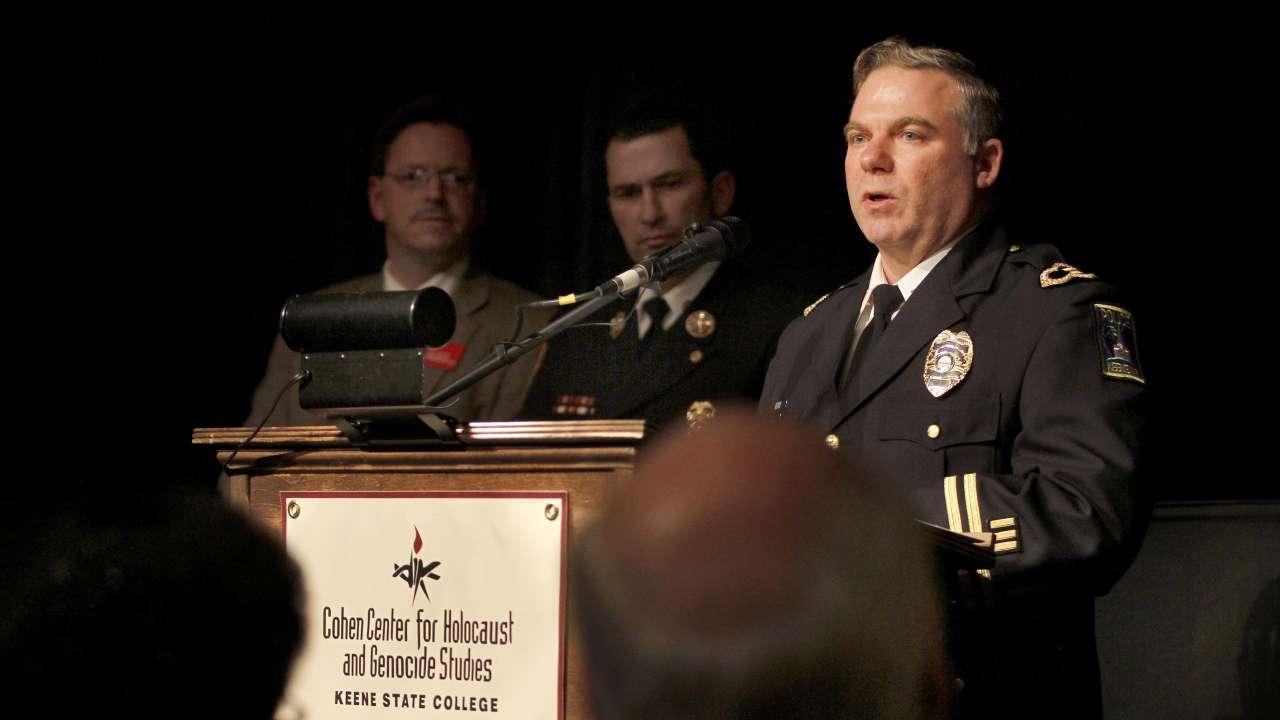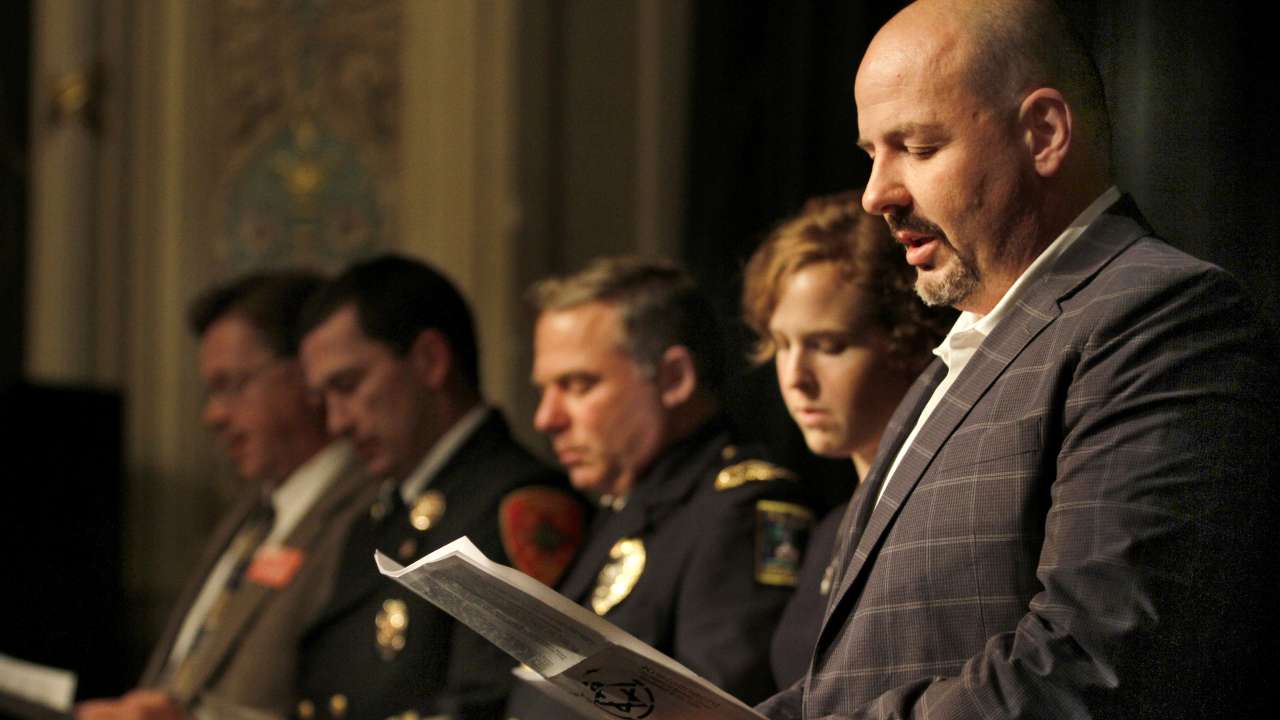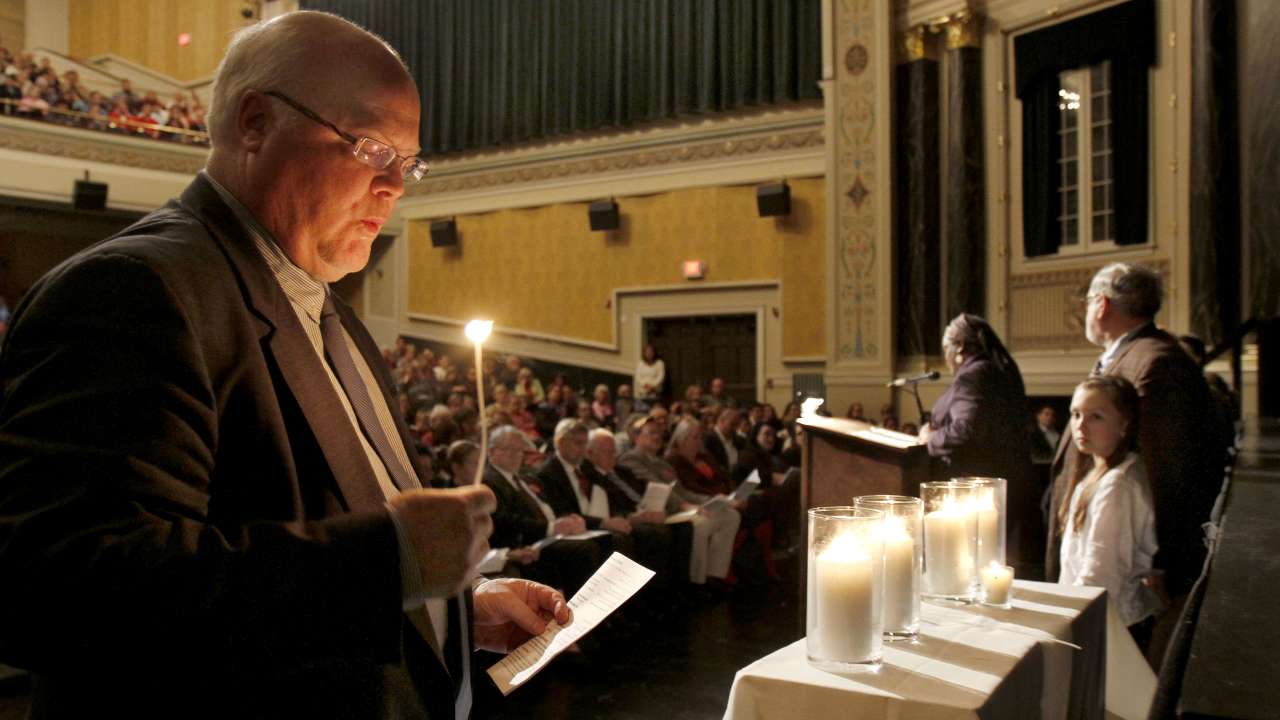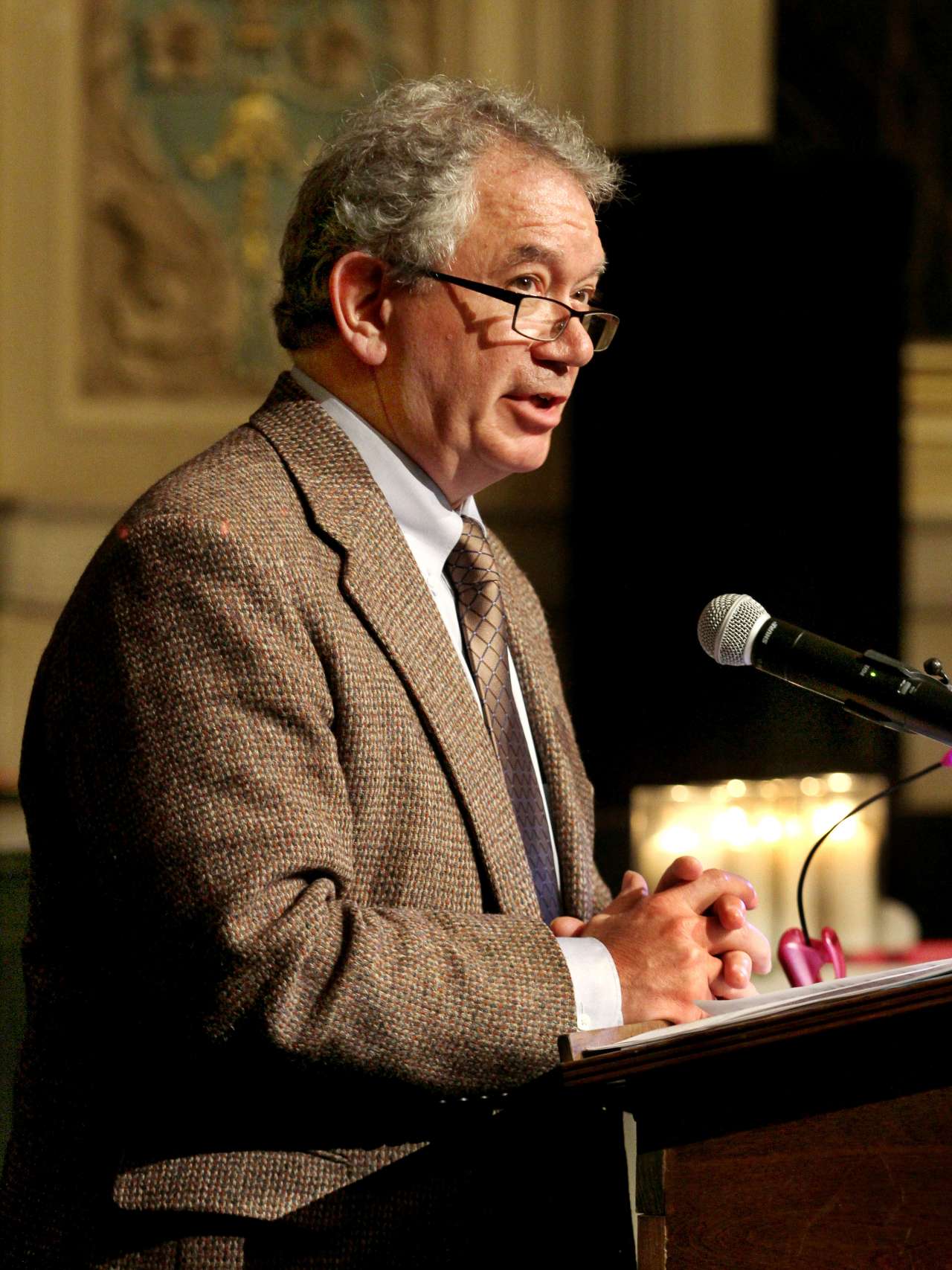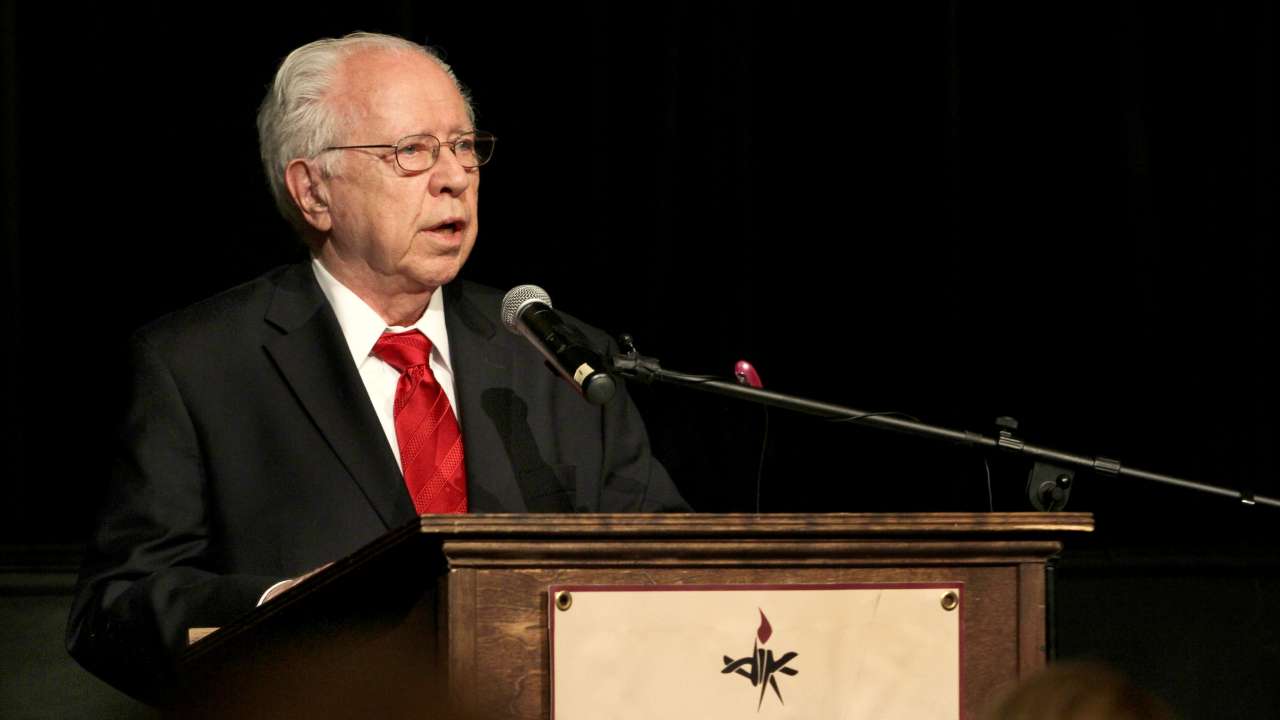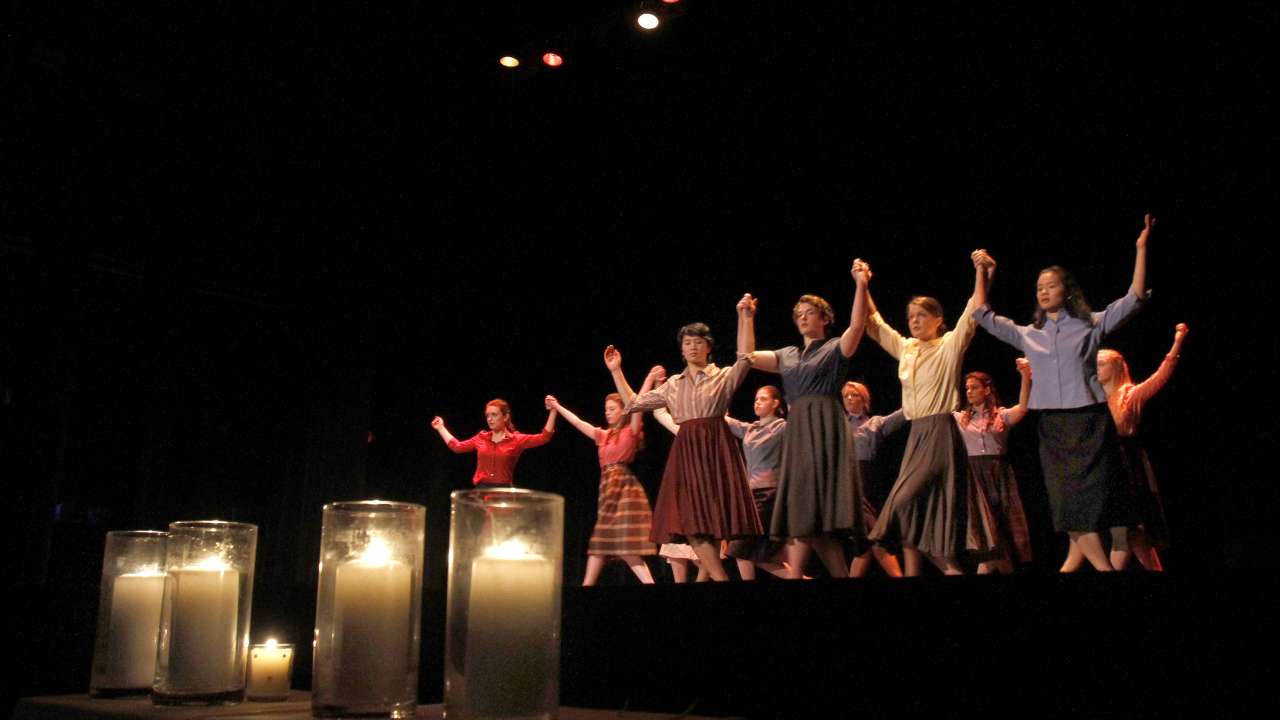Kristallnacht Remembrance Program
This annual event seeks to bring the community together to bear witness and recognize our responsibility to promote an active and informed citizenry, recognize individual and societal responsibility for each other, and foster mutual respect and justice.
This was an evening I will not forget. I was so touched by how many people came and how so many different people were involved. You are doing an amazing work! Every evening I wrote down new ideas I got from what I saw or heard. I got a lot of inspiration. Thank you.
Gunda Trepp (2012)
The Remembrance is held in the heart of the community in downtown Keene’s Colonial Theatre. It includes candle lighting; eyewitness testimony; participation by the mayor, police and fire chiefs of Keene; community groups such as MoCo Arts; and a candle recessional. The Remembrance is free and open to the public.
Though remembrance, the evening is a way to allow us to mourn together as a community, recognize what was lost, and remind ourselves of the work we need to do to strengthen our compassion and our hospitality. We recognize our responsibility to care for others in our midst who might be overlooked, targeted, or victimized in their circumstances. It is the mission of the Cohen Center to promote human dignity and civic responsibility while confronting the escalating violence that leads to atrocity and genocide.
Past speakers Keynote speakers have included:
- Kathy Preston, hidden child from Hungary
- Stephan Lewy, survivor and eyewitness of Kristallnacht and U.S. Army “Ritchie Boy”
- Michael Berenbaum, Director of Sigi Ziering Institute, Professor of Jewish Studies, American Jewish University
- Gunda Trepp, widow of Rabbi Leo Trepp (2012 Tribute to Rabbi Trepp)
- Congressman Tom Lantos and his wife Annette Lantos, rescued by Raoul Wallenberg
- Pierre Sauvage, Le Chambon Foundation;
- Gerhard Weinberg, the 2001 Shapiro Senior Scholar in Residence at the United States Holocaust Memorial Museum in Washington, D.C.,
- Dr. Hans Heilbronner, survivor and eyewitness to Kristallnacht
- Marion Pritchard, Dutch Rescuer and Yad Vashem recognized “Righteous Among the Nations”
- Warren Priest, Liberator of Dachau and Buchenwald and founder of the “Buchenwald and Beyond Foundation”
- Sibylle Niemoeller von Sell, widow of Pastor Martin Niemoeller
- Dr. Martin Rumscheidt, theologian
- Peter Eisenstadter, second generation survivor
The event illustrates how the Center confronts contemporary issues of genocide, injustice, and bigotry through the memory of the Holocaust and has served as a model for other communities wishing to commemorate these events.
What Was Kristallnacht?
Begin pull-quote…More than 700 people gathered in downtown Keene, at the heart of the Keene commons to recall the events of November 9-10, 1938 that shattered the commons of Germany. People of all ages, races creeds and backgrounds came together to reinforce the multi-cultural and pluralistic world in which we live and reminded each other of what a precious and precarious privilege it is to live in one such community. I was moved again and again. This was Holocaust remembrance and Holocaust education at its finest. …end pull-quote
Genocide is a process with many chances to stop or shift its momentum. After more than five years of growing Nazi power and persecutions, Kristallnacht was unleashed against Germany’s Jews on the evening of November 9, 1938. Although portrayed as a “spontaneous” action in response to the shooting of Ernst vom Rath in Paris two days earlier, the pogrom (violent mob attack generally against Jews) was planned well in advance and coordinated by the Nazi party’s security apparatus. 267 synagogues were burned or destroyed, 7,500 Jewish businesses were vandalized or looted and at least 91 Jews were killed. Many Jewish cemeteries, hospitals, schools, and homes were attacked as police and fire brigades stood aside. Kristallnacht ended all illusions about Nazi intent and marked the onset of mass deportations of Jews to concentration camps.
1938 had seen an intensified focus in anti-Jewish measures as the Nazis experimented with ways to “solve” the “Jewish question,” expropriate Jewish possessions and finalize plans for a European war of “race and space.” Kristallnacht was not a departure from Nazi policy, but a growing culmination of actions seeking the removal of Jews and Judaism from German life while looting the victims. Instigated by Joseph Goebbels and approved by Hitler, Kristallnacht was public and personal. Not all Germans condoned the events, but few were surprised and many “bystanders” took part or benefited. Jews were blamed for the violence inflicted upon them.
Since the 1930s Americans have been confronting the implications of Nazism, its appeal to authoritarianism and racism, and its echoes in our own history and society. Unsettling too was that Nazi race laws had been built upon American ones. Although the Nazis at first rejected Jim Crow as too radical, they studied U.S. eugenics, sterilization, and race-based immigration and marriage laws, in order to formulate their own. Despite President Roosevelt’s public condemnation of Kristallnacht, a Roper poll revealed that 77% of Americans rejected allowing larger numbers of German Jewish refugees into the country. How do refugees, fearing for their lives, challenge our humanity?
In retelling this history tonight, we remember those who suffered during Kristallnacht while also imagining how we might make a difference in our world today. Indifference only aids the perpetrator. We must listen to those who have been targeted in order to perceive danger and strengthen the foundations of our democracy against current threats like fascism and white supremacy. We must be more resilient than those who use fear and violence to divide us and embrace a future with strengthened democratic institutions and norms.
How do we embrace diversity as the strength of our Republic and build peace in challenging times? How do we embrace the core values of democratic citizenship? The Cohen Center for Holocaust and Genocide Studies advances the public liberal arts mission of Keene State College by promoting human dignity and civic responsibility while confronting the escalating violence that leads to atrocity and genocide.
Tom White, Coordinator of Educational Outreach, Cohen Center
Why We Remember
We remember that night as a moral obligation to the victims and the survivors as well as for ourselves, for the sake of our children, and for our community.
We recognize our responsibility to care for others in our midst who might be overlooked, targeted, or victimized in their circumstances.
We remember so that individuals may refuse to become perpetrators, “bystanders” or collaborators.
We remember in the hope that present and future generations take responsibility for building a world free of antisemitism, bigotry, intolerance, and hate.
Therefore, we remember Kristallnacht to remind ourselves to care for one another, to build peace, and be a community in which compassion, respect and justice thrive.
Candle Lighting for Memory and Hope
To be read before the lighting of the first candle: For Victims of Nazism
We light this candle as we recall with bitter grief the six million Jews murdered in the Holocaust and to remember the countless Roma/Sinti, handicapped, homosexuals, Jehovah’s witnesses, Poles, and others who were targeted and destroyed by the Nazis and their collaborators. May we never be numbed, indifferent or complacent to the magnitude of this horror. In honor of their memory, strengthen our commitment to make a difference and to never forget.
To be read before the lighting of the second candle: For the Children
We light this candle in memory of the 1.5 million Jewish children and all children whose lives were taken from them by the Nazis and their collaborators before they had had the opportunity to live. In their memory we commit ourselves to all children and the world they inherit.
To be read before the lighting of the third candle: For Refugees
We light this candle to remember the plight of the refugee who has been forced to flee because of persecution for reasons of race, religion, nationality, membership of a particular social group or political opinion. May this candle remind us to open our hearts and minds to those, who in their desperate need, seek safety and a place to call, “home.”
To be read before the lighting of the fourth candle: For the Righteous Among the Nations
We light this candle in honor of those compassionate men and women who, at the risk of their own lives, saved Jews from the Holocaust. Erzsebet (Elizabeth) was a teenaged neighbor who rescued 5 year old Kathy Preston in Hungary. In the midst of the most frightening reality, they made room for their Jewish neighbors. May the memory of these righteous individuals guide us in helping others and creating peace and justice in our world.
To be read before the lighting of the fifth candle: For Targets of Hate and People of Conscience
We light this candle for those who are targeted by hate and to recognize our responsibility to defend and protect them. We remember the life and sacrifice of Keene’s Jonathan Daniels and other people of conscience who answered the call to work for civil rights in our nation. May their courage help us to recognize our responsibility to protect human dignity by responding to racism, hate, and bigotry. May we be inspired by the knowledge that the actions of a few can change the direction of many.
To be read before the lighting of the sixth candle: For Our Community
We light this candle to inspire us to continue to build a resilient community in which respect and justice thrive. May we be a welcoming place and never forget our responsibility to others who are marginalized, not for what they have done, but because of who they are. We recognize that when any one of us targeted, wounded, or humiliated, all of us share the burden of responsibility.
Witnessing Kristallnacht: Stephan Lewy, child witness and survivor
Kristallnacht – A Night To Remember
The date was November 9, 1933; the place, a Jewish orphanage in Berlin, Germany. On that night, uniformed Nazi police herded all 100 children into the synagogue, severing the gas line fueling the eternal light and bolted the door from the outside, leaving the children to die. I was among those 100 children.
Fortunately, one of the older boys recognized our plight and threw a chair through the stained glass windows, releasing the deadly fumes and saving the lives of 100 children. This, of course, was Kristallnacht, the Night of Broken Glass, which left 91 Jews dead, 30,000 incarcerated and 7,500 shops and 300 synagogues vandalized and destroyed. This destruction can best be described as the END OF THE BEGINNING and the BEGINNING OF THE END.
1938 – A Year I Will Not Forget
Just before the year 1938, Jewish and gentile students were segregated into separate school buildings. While we were provided with the same education, we had to deal with one additional problem. After school on most days, the Jewish students were forced to run a “gauntlet” of Hitler youth, who whipped us with their steel-buckled belts while the police stood by to make sure that we didn’t defend ourselves or fight back.
On my 13th birthday in 1938, I had my Bar Mitzvah at the orphanage synagogue, which consisted of a service and a small lunch. It should be noted that the service was attended by two Nazi secret service agents. They were wearing civilian clothes in order not to be identified. I can only guess that they wanted to make sure that neither the rabbi nor I should say anything against the government.
That evening we invited about 10 guests to my parents’ apartment for dinner. As we entered the apartment building, we were met by an SS Trooper, who arrested my father. We waited and waited, and as luck would have it, my father returned late that evening. Why the arrest? The German government decided to give each soldier who fought in WW I a medal. Why on this day did they choose to give him this medal? Why did it take 8 hours? The best gift for me was that he returned home unharmed.
The constant fear of loved ones being arrested and harmed and beatings was a heavy burden to carry. Should we forget what happened? Absolutely not. Should we remember? Of course we should, so that we make sure that this will never happen again.
We Commemorate
Keene, NH - A Community That Cares
Coming together each November to commemorate the events and trauma of Kristallnacht has become a community tradition for us. Why do we choose to do this? With the exception of those here tonight who did experienced those terrible days, we know that their trauma was not our trauma. We know that Kristallnacht erupted in a different place and at a different time. Yet we recognize that when we place our experience within a larger context of their experience, we gain a broader perspective and a better sense of what our roles and responsibilities should be. Kristallnacht has become a touchstone for us - a bridge to something unsettling - as we explore the impact of extremism and prejudice on society. Coming together is our way of not looking away, of reminding ourselves and our children to be attentive to the needs of others in order to further the common good through compassion. It forces us to reflect and ask difficult questions: What can we draw from this experience? How do we recognize the dangers to human freedom when we target others? How do we resist prejudice and extremism? How do we responsibly live in the shadow of experiences like Kristallnacht and the Holocaust? What is required of us?
These are questions that our community does not shy away from and is reflected on the city’s web page:
“We envision a strong, just and resilient city where the health and well-being of Keene and the people who live, play, study and work here are nourished and supported. We visualize a community where our residents work together and participate in meaningful civic life.”
As most public officials in Nazi Germany looked away or followed orders not to intervene during the November pogrom it is indeed a powerful moment when our city officials stand with us tonight to publicly rededicate themselves to their mission to serve, protect, and minister to all members of the community. We will be asked by the mayor to join together in a statement of solidarity and witness and pledge our commitment to care for one another.
I would like to tell you what an incredibly good day it was for me to be among you and to share with you in your labors as teachers of the Holocaust. The warmth with which you received me, the attentiveness with which you listened to me and responded, the challenge and affirmation you gave me and, above all perhaps, the renewed energy and confidence you instilled in me – all this and more makes me profoundly grateful to you. I now have you all as companions, indeed, I would say: guardian angels, on my way. I shall remember my time with you for long and hold you in my thoughts. Let me assure you that I accompany you all on your journey in this important commitment you and I share together. I wish you my best and hope that our paths may cross again, and I may meet the four of you, who were present not ‘in the flesh’ but certainly ‘in spirit.’ - Dr. Martin Rumscheidt
Community
Keene Fire Department
The mission of the Keene Fire Department is to provide levels of excellence in emergency, prevention, education and community services to minimize loss of life and property damage due to fire, hazardous materials, medical and other emergencies in an efficient, professional and fiscally responsible manner. We serve our community and are responsible, as professionals and individuals for our actions.
Therefore, we choose to remember, to teach, and be resilient.
Keene Police Department
The mission of the Keene Police Department is to protect life and property and to maintain order within the City while assuring fair and respectful treatment of everyone. As members of the Keene Police Department, we commit ourselves to being capable, caring people doing important and challenging work for the benefit of all citizens within our community.
Therefore, we choose to remember, to teach, and be resilient.
Keene Interfaith Clergy
The Keene Interfaith Clergy Council brings together people of various faith communities for common purpose in social action and prayer. We look to our faith to lament the sins of the past and work together for justice in the future, remembering the words of Isaiah 43:
‘You are my witnesses.’
Therefore, we choose to remember, to teach, and be resilient.
The Keene Human Rights Committee
exists to promote the principles of social justice, non-violence, equity, diversity, inclusion, and multiculturalism through educational programs, community service and public events. We celebrate and honor the significance of the lives of Martin Luther King, Jr. and Jonathan Daniels. Therefore, we choose to remember, to teach, and be resilient.

